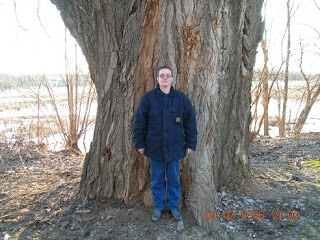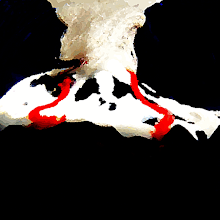 The illustration is my own. The Ginkgo is lovely with a reputation of smelling bad.
The illustration is my own. The Ginkgo is lovely with a reputation of smelling bad.The female Ginkgo is infamous for the stench of her squishy fruits. I have had numerous encounters with this tree when I was a child. My first encounter was as a junior high school girl on a paper route delivering store ads in Ventura, California. Even then I was fascinated with trees and read every book I could find about them. I was already familiar with the legendary female Ginkgo and her putrid fruits. I was walking down a quiet street with my back aching from my bag full of Two Guys ads. There I was confronted with a giant, rather majestic Ginkgo and her mate. The sidewalk was slimy with her fruit drop, but the tree was a thing of beauty with her branches spread against the grey winter sky. There was no putrid smell as described in the books. I passed by that tree week after week and never once did she reek in the cool Ventura clime.
Now in my years in southern California I did encounter two stinkers in the Tree kingdom, neither of which are the Ginkgo. The first is the Ailanthus, Tree of Heaven. The cambium and leaves of this tree give off a foul smell when crushed. The pollen of the male stinks.
The worst stinker I have met is the Acacia. This fellow's cologne smells something akin to axle grease! Parks in California love to plant this guy because of his showy white or purple blooms.
Since moving out of California I have met another stinker, the Bradford Pear. In the Spring she is a lovely looking cloud of white flowers, but she smells like Play Doh. I presently have one of these pungent ladies on the corner of my front lawn. Neighbors, long moved away are the ones responsible for planting her.
Now back to the Ginkgo. When I joined the Navy, I moved from California and didn't see another Ginkgo until I settled in Lincoln, Nebraska. Lincoln is a city of trees. Streets would have a theme tree. One of its main avenues has the Ginkgo. Many of these lovelies make their home in Lincoln. On one street there is one very large majestic tree--female. She looks like a matriarch looking over her brood. Still no smell, even though she fruited quite well one year. Her care taker cleaned up after her. The following year she didn't fruit. I wonder if he sprayed her with something or if the wind shifted and her beau could not blow her his kisses. Then I was walking down the same street on a blazing hot September afternoon and I was hit with this
awful smell! It was not unlike a bedpan after a sick person has used it. I looked down to see tawny wrinkled berries. My eyes followed the mess of berries to a yellowing lawn and its golden leafed occupant. She seemed smug as a cat scurried up her silver grey trunk. This was the my first and only encounter thus far with Eau de Ginkgo.
So in order for a female Ginkgo to smell, the weather needs to be hot and her fruit needs to be allowed to just lie there. I have read it is the pit rotting that produces the vomit-like stench. Here in the little rural town of Windom where I now live, the town square has a Ginkgo couple. Fortunately, the park keepers clean up after the lady Ginkgo, so there is no smell.

 I discovered this grand lady not long after I moved to Minnesota. She is about a block from my house across the street. She is about 150 years old and her crown soars some 120 feet into the air. Behind the property where she grows in a conservation center full of younger cottonwood trees. It is a veritable grove of cottonwood trees with leaves that glitter and dance in the Summer. I wonder if these are her progeny. She sheds clouds of cottony seeds in the Spring. The winds come out of the West carrying those seeds into the wet watery conservation center.
I discovered this grand lady not long after I moved to Minnesota. She is about a block from my house across the street. She is about 150 years old and her crown soars some 120 feet into the air. Behind the property where she grows in a conservation center full of younger cottonwood trees. It is a veritable grove of cottonwood trees with leaves that glitter and dance in the Summer. I wonder if these are her progeny. She sheds clouds of cottony seeds in the Spring. The winds come out of the West carrying those seeds into the wet watery conservation center.









